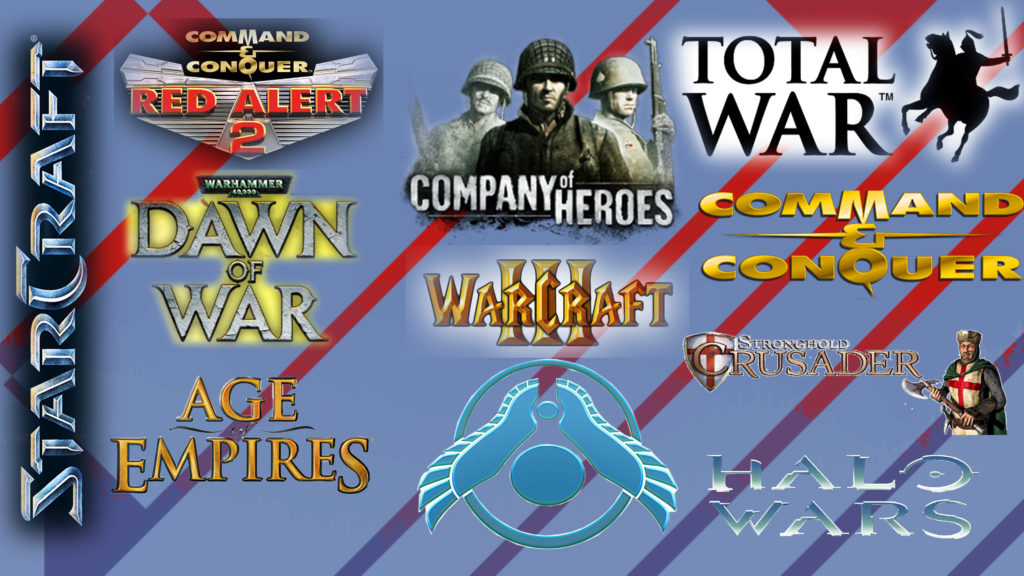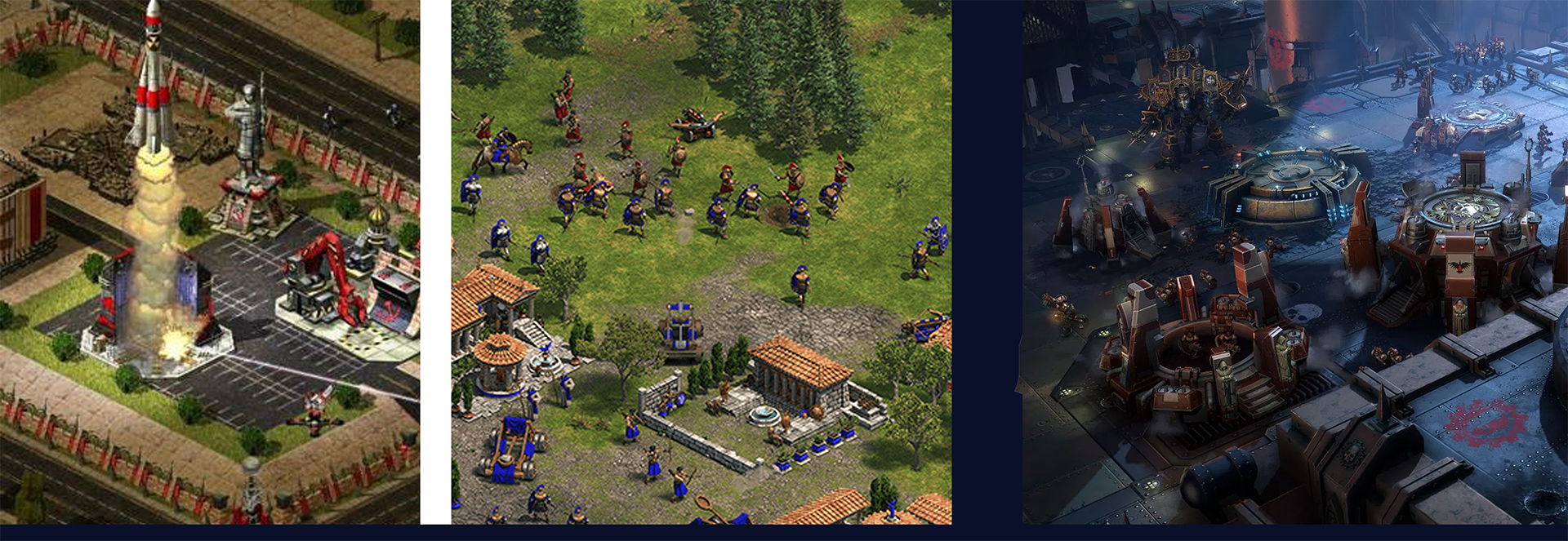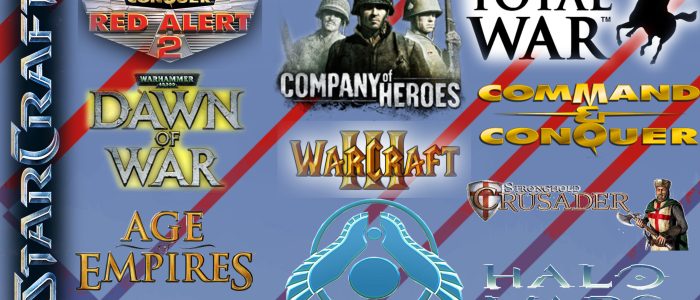Real Time Strategy games: A Retrospective Reflection

Real Time Strategy games: A Retrospective Reflection
Real Time Strategy (RTS) Games are a genre of simulation games which typically simulate war and the management of resources, defences, units and base building again multiple opponents. There are many scenarios in which these games have dipped their toes into, ranging from fantastical deserts with giant worms to space ballads with lasers and massive ships.
However, such games are dwindling both in numbers and popularity. There are a couple of reasons for this, and we will explore these.
Huge advances have been made in the last twenty years (that’s when Starcraft Brood War was released) but, except Total War series (which lets you track arrows and for more troops, visual fidelity is very good, and the historical approach is a huge part of the appeal), technology has not helped the Real Time Strategy (RTS) games grow as much as other genres. Fundamentally, it is still the top-down isometric view, fluid camera controls, and zoom functions… but even Ray Tracing can’t save the 1999 level of gameplay.
“You will be left behind when you choose to remain behind.”– Gugu Mona
Blizzard’s Warcraft 2 caused a genre split. The Multiplayer Online Battle Arenas (MOBAs) which allowed some people to have only the tactics and command, which gave rise to games like League of Legends, Defence of the Ancients 2, Heroes of the Storm, SMITE and so on. This was what the Massively Multiplayer Online (MMO) games always wanted. Base Building players got games from iPhone like Plants vs Zombies, which was especially suited to the touch screen interface.
Criteria RTS games need/missing
Importance of 3D
Every single RTS that focused on 3D, rotating view, graphics over play ability lost gamers shortly after launch as the 3D engine was just not working for RTS, but the other games did it better. 3D became better for Role Playing Games, for even action games. RTS games never really focused on 3D and it was not evolving its other mechanics.
Therefore, the RTS games failed to even appeal visually to most of the players it interacted with. Then there is also the fact that when there was action, it felt too far away, too remote. Players always want to be in the thick of it, as they say.
Custom content and Map editors/MODs
Players often get to make and enjoy custom made content like reskins and map editors of successful RTS games, content that comes with the game itself. RTS need or needed custom content in order to encourage replay-ability. New units/maps allow the player to experience new stories, which are key to the survival of RTS games. Red Alert games are still getting Mods that introduce new things into the play or just allow a wholly different experience.
Skirmish/single player campaigns
While most Corporate marketing departments seem to think that most games are multiplayer focused, they are wrong. Multiplayer has always been an add-on to the original single player story campaign that had an appeal of its own.
Furthermore, even skirmish- which puts the human player against AI bots in a freeform gameplay- is crucial to experiencing your own custom scenarios with implausible factions, and is crucial to fun.
Amount of unit/sides/diversity types & Unit experience, customization, player profiles, unit upgrades, tech trees
The above is simply a must for any RTS game worth its salt.
The diversity in gameplay is something Starcraft 1, 2 and Warcraft 3 did amazingly well. Real differences between units, builds and strategies became apparent because all the Factions had considerable differences, to the point that most of the time, a strategy used for one Faction may well be the death mark for another. The Terrans? of Starcraft, for example, are middling in tech but have some very powerful air units; the Zerg? have numbers and resupplies capabilities that are better and faster. While the former may engage in aerial dominion, the other cannot, simply because their air power comes from diversity and number of troops; the Zerg are known for typically overwhelming force with too many types of attacks. Effectively, while the Zerg outgun their enemies, the Terrans cannot do the same; they must focus on smaller, higher quality units that focus on raw power than numbers.
Related to the previous point, we find that each unit should be, well?, different and unique, and more importantly, not a colour inverse version of an opposing unit. This actually was the case with Warcraft 2, where the Orc and Humans would each have similar units, with different looks, and unfortunately this extended to the most of the other units too. Basically, that made the game extremely boring. Unit customisation is key to delivering a good player experience, and choices on specialisations can further add to this experience.
For example, there are some choices in StarCraft 2 for specialisations for units. One Zerg Faction unit can become either burrowers and stealth specialist while the other specialisation allows flight and traversal of difficult terrain, allowing units to move over otherwise impassable areas to stage attacks. More choices are available at multiple points of each campaign factions. These factors?, overall, increase the replay-ability and gives the players a sense of depth to their choices.
Isometric view is the KEY
Even if you do it 3D, keeping it/locking it to Isometric for the sake of navigation, orientation is best for RTS and RPG.
Isometric view is key to how an RTS game works. The player needs a wide view from which to see what is happening as they are controlling this at a very, very large scale. The movement of troops, the mini-map for seeing the activity and the interface work best with the Isometric view.
Any other view just brings us too close to the action of a replicable unit, and we lose sight of the big picture, literally. This can be disastrous. However, the 3D that is middling and too far away seems like a loss in the age where players want to look at very cool and pretty things up-close.
All of this applies in the same way to RPG games; some games cannot do without isometric view, such as the legendary Baldur’s Gate franchise.

Rise of console markets
Consoles are easier to play, cheaper and overall a better budget option for many gamers. The console markets are also simple control schemes, which didn’t afford the complex way the RTS games worked. As time has moved on, the console games saw the boom of platforming, First Person and Third Person games of every genre. This meant that those games were more popular, and some even got PC releases. The console market flourished and the RTS genre, unable to switch to console due to its complex control schemes and gameplay, could not keep up with the market.
Rise of character focus rather than large scale settings
As graphics and processing power increased across the board, with a 5-year difference meaning several times difference in graphical fidelity and engine capabilities, it became much easier to focus on details, and by extension, the characters and what they do. By 2010 most games had a very keen focus on non-RTS games, such as Role Playing games (RPGs), First Person Shooters (FPS) and Independent titles ranging from puzzles to mystery to simulations of life.
Death of mid-range titles & Loss of licenses games and death of niche genres
The RISING COSTS of game development meant that middle level titles could not keep up with more moneyed developers. For example, a $ 1 Mn game might look the same as a $ 5 Mn game for RTS games, but the fact is that the other games just did it better. A game that is bigger, more invested in, and more hyped will get more returns. (AC Origins vs Starcraft 2)
Problematic gameplay loop
The problem with RTS games is that the process of start weak, get stronger, achieve victory is then followed by having to restart from scratch again. There is absolutely no post-powerful form exploration and fun. This is actually the reason why RPGs are so fun as the players earns their status as a Samurai god or a monster slayer, and the game doesn’t stop when they achieve the highest rank. Part of the fun comes from being able to pummel previously difficult enemies.
Success of MOBAs AKA Simplified and improved the gameplay loop enhanced
Removing the base building and the above problem loop means there is less time spent in it, so more games can be played. The Multiplayer Online Battle Arenas (MOBAs) diversified the skill sets and play styles so much so that with each new IP that it just doesn’t feel routine the way RTS usually do. MOBAs
The dominion of Blizzard
Blizzard came and released the stellar Starcraft 20 years ago. It was a game that introduced not only new mechanics but introduced real differences between the Factions. This enhanced the gameplay in a way never seen before in any game whatsoever. Then, Warcraft 3 took the scene by storm, with its expansion further dominating the RTS genre. The competitive scene also was basically reinvented by the games mentioned above, with the games not losing steam even a decade after release and the sequels. Star craft 2 and the scene basically was instantly revitalised, restarting the cycle yet again.
Blizzard is truly the giant of RTS games with no challenger on the horizon… and its been a while too. No other contemporary studio can match them, and it has been a long time. Games like Civilisation and Total War etc have managed to make their mark but none of them have even come close to the scale needed. How is the dominion of Blizzard related to the Topic?
Presentation failure
The weakness of RTS games is the ISOMETRIC view that causes the details to be taken at the meta level, therefore individual details are only lightly modelled. For example, each empire Faction in Age of Empires has their own distinct faction style but that does not mean the player can see the embroidery on the cloak of the samurai or the King’s robes. Other games, however, allow for so much more detail. Assassin’s Creed Origins has our character, Bayek, decked out in several different and frankly very cool outfits.
Revival and problems of RTS
In addition to the above-mentioned factors, many other small but significant problems also came up impacting the way RTS games have fared in the last two decades. There has been mishandling development teams. The best example here is the Westwood studios, who closed after lack of funding and interference from Electronic Arts, all because of some arbitrary sales mark. This is par of the course for EA, which has a history of shutting down studies left right and centre.
The controversial move to move the Command and Conquer Tiberian Sun to mobile games did not help as it killed the whole spirit of the game. It was never meant to be a mobile game. Also, mobile games do not have the scale or power to run such large games, so obviously a lot of stuff was over simplified. Furthermore, loot boxes and microtransactions were added. What followed suit was some massive jeering and boos.
Conclusion
Even today, much of the tech in RTS is old and primitive and the genre hasn’t really developed all that much. Also, the time it takes to complete a game is now more than many more popular genres, such as MOBAs. The main mechanics have not changed even after the dominion of Starcraft hits the second decade mark, and there seems to be no one willing to take the risk to change up the formula.
It seems that perhaps RTS games need to come from the Emperor of RTS games- Blizzard- themselves. No one else has that kind of money, scale or risk-taking courage.
At the industry level, there has been a change of gaming culture: short games, short engagement. Typical RTS games, however, require several real time hours, which is too much for new players. Also, the skill requirements to play an RTS well is too high for new players, as the learning curve is simply too steep (too much to learn in a very short amount of time) which bars most of the players from casual play. Other games just take up less time, and overall easier skill learning systems.
Notwithstanding the problems RTS games are facing over the last two decades, there have been big RTS strides as Company of Heroes and Dawn of War 2 took RTS to different directions; traditional but with new mechanics. However, they simply did not innovate enough to keep the flow of the games. They are both now fairly aged, and it seems Starcraft has the cake, all of it all the time.
Outside of Starcraft 2, RTS seems dead in the water/stagnant, if you want to be generous. The e-sports scene is bustling and vibrant, but the game is still essentially the same. There seems to be little chance things will change. Something needs to be done, but at what cost? It is simply way, way easier to go for better investment opportunities, whether it be time for players or money for venture capitalists.
RTS games do need a revival, but it will take a lot for that to happen. Changing the formula to more than just a gimmicky improvement will take a lot of research time, testing and failed games; it is safe to say change is hard for this genre. On the surface, it just seems to work, quite well. However, technology advancements have allowed games to go from single CD affairs for a few hundred MBs to 100 GB plus behemoths with lot of features, and even more variety.
A single RPG game, the likes of Witcher 3, which is five years old currently, had the elements of crafting, item collection, achievements, intricate combat system, dialog, choices, amazing graphics, a massive world that a latest generation mid-range laptop can comfortably run.
RTS games need to up the Ante and include other genres into their gameplay; an RPG system with individual characters, deeper and vast campaigns, integrated mechanics of other popular RTS games, and genre expansion need to happen. Sometimes, a stagnant genre needs a blood transfusion from the giants and it is high time that this happens; clearly, home base has been found wanting for a long, long time.
If RTS games need a revival, they need to, in essence, get into the modern era.



